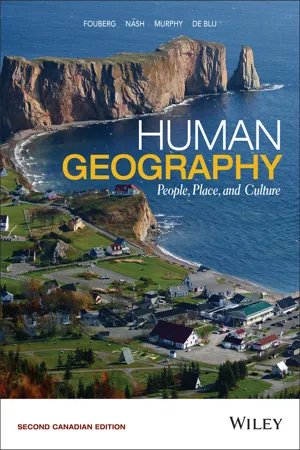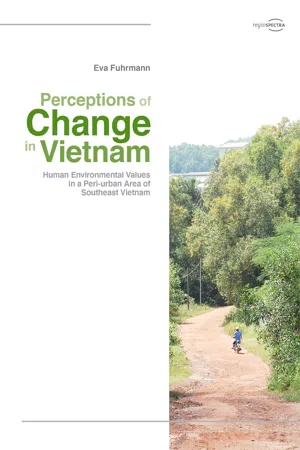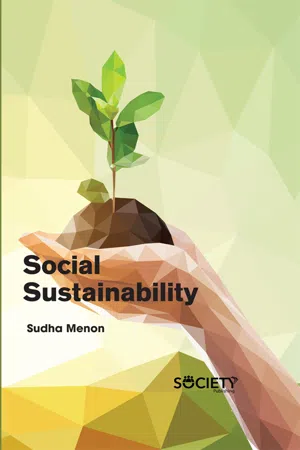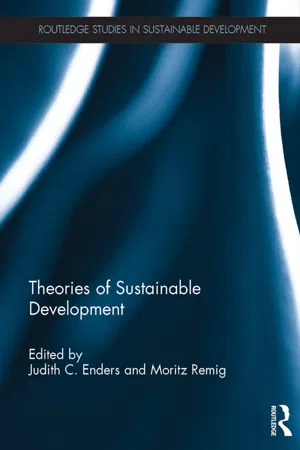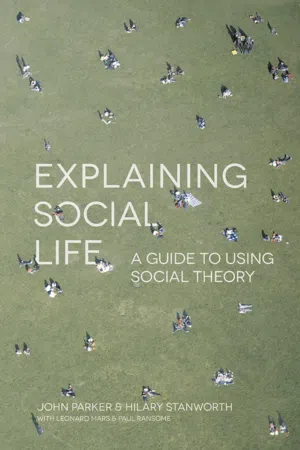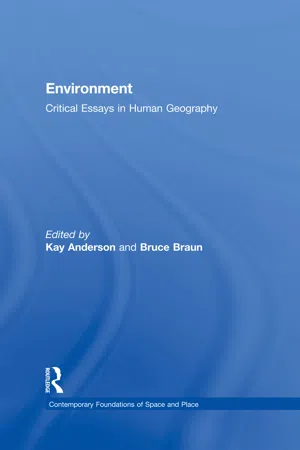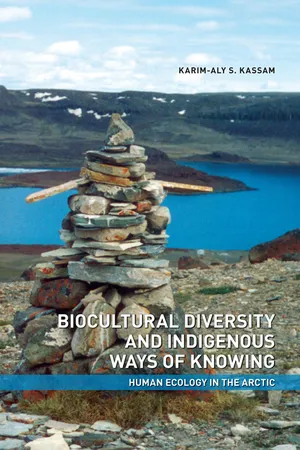Geography
Nature and Society
Nature and society refer to the interconnected relationship between the natural environment and human society. It encompasses the ways in which human activities impact the natural world and how the environment, in turn, shapes human societies. This concept is central to understanding the dynamic interactions between people and their surroundings, and it is a key focus in the field of geography.
Written by Perlego with AI-assistance
Related key terms
1 of 5
10 Key excerpts on "Nature and Society"
- eBook - ePub
Geography
Why It Matters
- Alexander B. Murphy(Author)
- 2018(Publication Date)
- Polity(Publisher)
A failure to embrace these complexities prompted some early twentieth-century scholars, including professional geographers, to embrace the idea that environmental context determines cultural and social outcomes (an approach labeled environmental determinism). That way of thinking led to some alarmingly simplistic, ahistorical, often racist views of the world – assertions, for example, that the people of the tropics are indolent and incapable of great achievements because the environment made them so. As geographers and others came to think more deeply about nature–society linkages, most of them abandoned that way of thinking, though it continues to crop up with some regularity among those who have not been exposed to geographical scholarship over the past seventy-five years (an argument in and of itself for the importance of studying geography). 2 In the wake of the rejection of environmental determinism, many geographers began focusing solely on either the physical or the human world. Nonetheless, a realm of inquiry fundamentally concerned with the nature of places and with the character and consequences of different geographical arrangements cannot ignore nature–society relationships for long, and geographical work on the subject has blossomed in recent decades. Indeed, of the traditional disciplines, geography today is the one that arguably is most centrally concerned with looking at the interrelations among and between natural and human processes on Earth’s surface. To be sure, many scientists and social scientists grapple with questions that cross the human–physical divide. To cite but a few examples, environmental chemists look at the impacts of human-caused pollution on water quality, forest ecologists seek to understand how human actions affect the diversity of flora and fauna in forests, and environmentally oriented legal scholars look for ways to design rules and regulations that can curtail emissions from the burning of fossil fuels - eBook - PDF
Human Geography
People, Place, and Culture
- Erin H. Fouberg, Alexander B. Nash, Alexander B. Murphy, Harm J. de Blij(Authors)
- 2015(Publication Date)
- Wiley(Publisher)
Our conceptualization of nature determines our relationship to nature, how we see our place in nature, and how we think we should interact with the natural world. Many human populations regard human beings and our society or culture as separate from the natural world—they believe we are somehow standing outside or beyond nature. In this conceptualization, nature tends to be a place we look out at or step into, a place we go to for recreation and leisure, relax- ation and rest. Nature is portrayed as an undisturbed landscape waiting to be discovered (and possibly developed) by humans. We often see nature as something to be conquered and overcome, brought under the control of humans for their own purposes. Television reality shows such as Survivorman and Mantracker portray humans battling the forces of nature (Figure 6.4). A common element of these ways of thinking is their organization of ideas about nature and humanity as a set of binaries or a set of opposing concepts: nature-culture, nature-society, nature-human. In each of these, we see reflected the idea that humans and human social relations (society and culture) are outside nature. We might question whether understanding nature as something separate from humankind fairly represents our re- lationship. Some argue that the current conceptualization of nature as distinct from society emerged during the Western Age of Enlightenment (17th and 18th centuries). In the late 18th and early 19th centuries, rapid urbanization and indus- trialization in Western societies radically altered human land- scapes, making the distinction between human society (urban) and undeveloped “nature” (the rural) quite stark. As we exam- ined in the chapters on globalization and political geography (chapters 2 and 3, respectively), this was also the age of impe- rial and colonial exploration by countries such as France, Spain, Britain, Belgium, and Portugal. - eBook - PDF
- R. Knowles, J. Wareing(Authors)
- 2014(Publication Date)
- Made Simple(Publisher)
Geography is first con-cerned with the study of man's relationships with the environment in which he lives, and secondly with the study of how man uses and organises space. These can be considered as two systems, or structures within which all parts are related to each other to form a functioning whole. In the study of man's relationships with the environment (which is used in this chapter to mean the physical environment), geographers are concerned with identifying and analysing the form and nature of the ecological system in which man interacts with the environment, being influenced by it and in turn modifying it. In the study of man's use and organisation of space, geographers are concerned with identifying and analysing the form and nature of the spatial system in which man interacts with man through his economic, social and political activities. Of course, these two systems are not independent of each other but operate on the one hand to divide the world into a number of distinctive divisions or regions, and on the other to link these regions together, especially through the resource processes discussed in Chapter Twenty-five. Man and Environment The idea of geography as the study of man's relationship with the environ-ment has a long history and has led to a long-standing debate about the posi-tion of man in relation to nature: first, whether man is part of, or apart from, nature ; secondly, about the extent to which man is affected by the environment. From Classical times onwards, the idea that man is a product of the environ-ment was dominant, and in the nineteenth century the work of Darwin in the biological sciences, which showed that life developed under the selective action of natural forces, seemed to confirm scientifically the position of man as a creature adapted to his environment. - eBook - PDF
Perceptions of Change in Vietnam
Human Environmental Values in a Peri-urban Area of Southeast Vietnam
- Eva Fuhrmann(Author)
- 2020(Publication Date)
- regiospectra Verlag Berlin(Publisher)
In the 1970s, the view of environmental sociologists seemed to change. When concern about the environment became more wide spread during this period, and disasters such as the nuclear accident at Chernobyl or the gas leak at an industrial plant in Bhopal in the 1980s demanded political answers, the environment also became more relevant to the agenda of researchers. At this point, there developed a growing interest in the relationship of society to its natural surroundings and, especially, the impact society has on nature and what these impacts imply for human societies (Groß 2011a: 11-12). In order to point out the differences between the two approaches, it can be concluded that while research was previously focused on humans and the relevance of the natural environment was merely a byproduct, the perspective changed to posit humans and their natural environment as equally important topics of research. The emergence of this new perspective in sociology challenged previously fundamental sociological concepts. From its inception as a discipline, the opposition between society and the surrounding material world had been a central element of sociology’s self-concept. This opposition allowed for a differentiation between the social sciences on the one hand and the natural sciences on the other. The opposition thereby also justified the existence of the discipline of sociology (Dunlap / Catton 1979: 244-245). Human-Nature Relations: The Current State of Research 11 The natural environment was now moved from its position as a side issue to a dominant social issue at the center of research: Humans were seen as an integral part of nature. This, however, does not challenge the dualism of nature on the one side and culture on the other. - eBook - PDF
- Sudha Menon, University of Kerala, India(Authors)
- 2019(Publication Date)
- Society Publishing(Publisher)
National boundaries demark nation states co-existing peaceful albeit with skirmishes like ethnic divisions, civil wars, temporary imperial adventures, collapse of government(s) and excesses inflicted by dictators. A common global ecosystem is shared by all humans world over and the effects of this are shared by all the nation-states. Human existence and its long-term sustenance are strongly dependent on the knowledge of the ‘natural ‘systems as well as the man-made systems and the overall impact of how humans live within these systems. Unfortunately, the influence of natural systems no longer influences humans as much as they did in the past. In the current times, patterns like climate change and variations in temperatures globally is largely a result of human intervention revealing that ‘human-influenced’ and ‘human-dominated systems are on the rise. Social science is essentially the study of social relationships and human society. But over the years, the term social science has seen extreme forms in its interpretation from being either too narrow or too wide. More often than not only synthetic social theory or sociology is defined in social science. Natural sciences have always faced a challenge when it comes to implied analogy. The Social Science Research Council which is financed publicly was challenged by the British Government in 1982 whereby it argued that the discipline of scholarship was more apt to the ‘social studies’ and that a scientific recognition thereof would be incorrect. Social Science: A Global Perspective 3 Incidentally, science is missing even from sociology and economics that have the strongest scientific aspirations and the core social sciences. Political science too has seen a difference of opinion amongst analyst and different scholars. - eBook - ePub
- Judith Enders, Moritz Remig, Judith Enders, Moritz Remig, Judith C. Enders, Moritz Remig(Authors)
- 2014(Publication Date)
- Routledge(Publisher)
The definition of society's relationship with nature on the basis of reproduction theory
A historical-systematic problem sketch Michael Weingarten DOI: 10.4324/9781315757926-11Sustainability has tended to be viewed, on the basis of the historic model of forestry, as a conception in which the conditions for the survival of human society are determined – even to this day. By contrast, the following sketch seeks to formulate the basic conditions under which the issue of sustainability might be transformed into a program of development theory. Formally, development can be defined as reproduction, non-identically extended. The implementation of this initially very formal definition can be oriented toward research programs initiated primarily by social geography, as a reconstruction of spatial structuring, particularly in everyday activity, and their confirmation over time as structures – which always means structures reproduced in activity. The underlying theory of activity has been systematically formulated in the dissertations of Claus Baumann and Jan Müller at the University of Stuttgart, and, with reference to climate change, in Karsten Gäbler’s dissertation in social geography at the University of Jena.Introduction
The theory of society’s relationship to nature takes as the point of departure for the development of its approach the distinction between ecological, i.e. strictly life-scientific issues on the one hand, and issues of environmental science on the other, the latter being concerned with investigating the manner of the incorporation of elements of nature into the reproduction of societal practice. It would, however, be a misunderstanding of this distinctive delimitation of the two disciplines to assume that the same object were thus merely to be investigated from two different aspects or perspectives. Rather, it should be noted that ecology and environmental sciences are first and foremost different disciplines, each based on its own guiding purpose, and, in accordance with those purposes, its own objects of investigation. When deciding whether and how theoretical elements of the life sciences are to be – or can be – integrated into environmental sciences, very close reflection and even translation will be required. The same is true with regard to the reverse case: to what extent can social-scientific findings obtained in the context of environmental-scientific research, be incorporated into ecology – and to what extent should they be? - eBook - PDF
Explaining Social Life
A Guide to Using Social Theory
- John Parker, Hilary Stanworth(Authors)
- 2017(Publication Date)
- Red Globe Press(Publisher)
Giddens, A. (1986) The Constitution of Society, Cambridge, Polity. Archer, M. (1995) Realist Social Theory , Cambridge, Cambridge University Press. DeLanda, M. (2006) A New Philosophy of Society, London, Continuum. What does nature explain? 61 it sees such beliefs and actions as requiring explanation in terms of non- supernatural factors. Sociologists of religion, for example, try to explain why such beliefs are held, and how they are used, but without being committed to their truth. ‘Nature’ as the natural environment: a conditioning factor To begin our consideration of more restricted concepts of ‘nature’ we suggest that another possible common-sense understanding of why social phenom-ena are as they are, is that they are the outcome of nature understood as the ‘natural’ environment in which humans live. This typically refers to the plants and animals examined by botany and biology, together with the Earth’s fea-tures and forces studied in geography, geology, astronomy and climatology which are understood as determined by a range of natural laws including those of chemistry and physics. In everyday thinking the natural environ-ment and ‘the laws of nature’ that help explain it are often thought of as substantially unchanging. And, at least in our modern, western world, the natural environment is often spoken of as in some sense ‘opposed to’ or quali-tatively different from the people who inhabit and are shaped by it. From such a perspective it might initially seem plausible to account for the specific characteristics, and differences between the ways of life, of peoples living in, for example, the Amazon basin, and those in the Arctic in terms of the radi-cally different natural environments they live in. Another example might be to explain a perceived difference in the speed of technological development between temperate and tropical regions as an effect of climate on the inven-tiveness of the respective populations. - eBook - ePub
Environment
Critical Essays in Human Geography
- Bruce Braun, Kay Anderson(Authors)
- 2017(Publication Date)
- Routledge(Publisher)
Part INature and Society: New Directions for Environmental GeographyPassage contains an image
[1]
Environmental Appreciation: Localities as a Humane Art
by D. W. MEINIGI
AMERICA’S “DISCOVERY” OF THE ENVIRONMENT in 1970 was so sudden and so sensational that we are as yet very far from realizing just what it all means. It was inevitable and appropriate, given the relative lack of attention over so many years, that this first spasm of concern should focus upon the problems associated with the environment; so much so that people now link the very word most immediately with smog and garbage, filthy streams, oil slicks, and used-car dumps. Now it is surely proper that we give first attention to life-endangering aspects of the environment, for our neglect has been so gross as to face us with genuine crises. I wish, however, to emphasize some life-enriching aspects, although I will go on to argue that the two are necessarily interrelated.“Environment” refers to that with environs, that which surrounds, that which we live amidst. Thus it clearly includes man as well as nature. It is “place” or “locality,” which may be taken to refer to areas and their contents defined at a human scale, areas we can directly experience. Logically, the locality most of us know best is that of our home area, yet inevitably that which is so familiar, so routinely part of our lives, tends to be taken for granted until something unusual happens to jar us into seeing more clearly through the daily blur. Travel and migration are probably the most common sorts of events which through freshness and comparison help us to experience our environments more fully. However if we seek to foster some widespread improvement in environmental appreciation we can hardly rely upon such erratic events. We need some sort of formal program. - eBook - PDF
Biocultural Diversity and Indigenous Ways of Knowing
Human Ecology in the Arctic
- Karim-Aly Kassam(Author)
- 2012(Publication Date)
- University of Calgary Press(Publisher)
A political scientist tends to con-centrate on a specific organizational response such as the governmental role in policy formulation, regulation, and implementation (Micklin 1984). 29 2: Relations Between Culture and Nature Political ecology has been concerned with balanced and harmonious tra-ditional systems that have been disrupted by forces of modern change. In political ecology structural relations of power have been seen as critical in understanding social, political, and environmental relationships. Therefore, the notion of politically and socially constructed resources is important to gauging environmental change from the perspective of different actors (Scoones 1999). In short, political science views the environment as a field of competing stakeholder interests. 2.5.3. Geography In geography the recognition of human behaviour and its impact led to consideration of linking organism to place. From the seventeenth to the nineteenth centuries, early geographers debated whether to study the influ-ences of the physical environment on humans or explain human relations in terms of the natural environment. In either case, it was recognized that human occupancy was connected to social phenomena. In 1903, when the Department of Geography was established at the University of Chicago, its aim was to dwell in an intermediate position between the natural and social sciences. Population geography became the most closely aligned to the no-tion of human ecology although geographers continued to debate nature and culture as separate entities. Furthermore, human geography in contrast to human ecology tends to proceed by way of the environment instead of by way of organism. As a result, adaptation as a means of change is not well developed in a geographical conception of human ecology. Nonetheless, ge-ography as a field of study provides a significant link between the biological, physical, and social sciences (Bruhn 1974; Hawley 1950; Micklin 1984). - eBook - PDF
- Noel Castree, David Demeritt, Diana Liverman, Bruce Rhoads, Noel Castree, David Demeritt, Diana Liverman, Bruce Rhoads(Authors)
- 2009(Publication Date)
- Wiley-Blackwell(Publisher)
Geography remains one of the few disciplines committed to bridg-ing the divide between the natural and physical sciences, on the one side, and the social sciences and humanities on the other. Quite how successful that bridging has been is a matter of some debate (see, for example, Matthews and Herbert’s [2004] book Unifying geography ). Despite the hopes invested by Turner (2002) and others (e.g., Marston, 2006; Zimmerer, 2007) in human–environment relations as the unifying link holding the discipline together, many geographers prefer to study other things. There is no shortage of ‘pure’ human and physical geographers. Even so, the scale and richness of geographers’ attempts to understand the entanglements of people and the non-human world are highly impressive. These many geographers, their findings and their ideas are what we are calling here ‘environmental geography’ 2 NOEL CASTREE, DAVID DEMERITT AND DIANA LIVERMAN (or what has sometimes also been called the ‘human-environment’ or ‘man-land’ traditions of geography’). By whatever name, environmental geography occupies the fertile ‘borderlands’ where geography’s various traditions of scholarship – not only human and physical, but also regional and GIS – come together and connect with each other and with cognate traditions of environmental work outside geog-raphy (figure 1.1). Though the term is perhaps less familiar than are ‘human’ and ‘physical’ geog-raphy, environmental geography deserves greater recognition both within and beyond the discipline. As this Companion is designed to show, environmental geog-raphy is much more than simply the residual intersection of geography’s two halves. Environmental geography is a large, diverse and vibrant field of knowledge with few, if any, equivalents elsewhere in the conventional academic division of labour. The 32 chapters of this book will, we hope, offer readers both an incisive and acces-sible introduction to this field and set the agenda for its future development.
Index pages curate the most relevant extracts from our library of academic textbooks. They’ve been created using an in-house natural language model (NLM), each adding context and meaning to key research topics.

